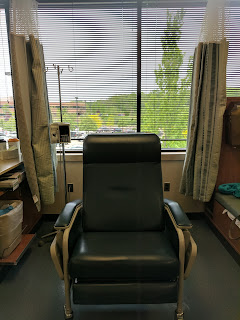There is a scene in my new favorite show, ABC’s “This is Us,” that had me tearing up recently. The show features the strength of familial love and commitment during the knocks encountered in life. One member of the multi-generational family has been adopted, having been abandoned by his addict father decades before.
They connect late in his biological father’s life, as he faces Stage IV (my favorite) stomach cancer. Even though this successful son devotes all of his resources, the father’s cancer begins to take over. It is time to stop chemo.
As the son comes into the kitchen in the morning, the biological dad, William, seems not only happy, he’s ecstatic. He’s ready to do anything, and especially, to hit the road, despite hospice care. Someone asks what’s with him. The answer, more or less: “He’s on a high because he’s stopped his chemotherapy.”
 I so understand that, completely!Chemo and the new biologics have their side effects, even if they are milder. Being off chemo means to feel well again; completely well. It’s a happy time. And it’s one I won’t get for a while, or maybe never. My regimen has been extended for at least two more rounds. And I will never by off some treatment. I can’t.
I so understand that, completely!Chemo and the new biologics have their side effects, even if they are milder. Being off chemo means to feel well again; completely well. It’s a happy time. And it’s one I won’t get for a while, or maybe never. My regimen has been extended for at least two more rounds. And I will never by off some treatment. I can’t.
It’s not that the side effects are horrible, but they are a problem. My poor GI system is entirely messed up. If it isn’t one issue, it’s another in that realm, and the problems can be unpredictable and embarrassing.
My nails hurt from the brittleness and tendency to split and dig in. My hair is just odd; I look like Carol from the Walking Dead with less hair. I have to cut the sides and back periodically or I look even odder. I can’t afford to lose anything off the top.
I have that tendency for infections I have to be vigilant about, especially urinary and bronchial (stay home if you have a cold, please!). I get tired and nap frequently. I get spasms and aches. Each and every one causes a moment’s concern that I’ve got mets there.
Although my husband insists I’m fine, I feel some cognitive impairment as well. I missed my therapist appointment today. I really depend on her and I’m angry that that happened. Retiring now is the right thing: I would have dropped threads eventually at work.
But, the regimen seems to be working, both visually (my chest is looking much better) and even according to my latest CT scan (my comments in italics):
“BONES/Other: Patient appears to be status post bilateral mastectomy. Elliptical fluid collection in the left chest wall is stable. Small calcification or clip in the superior right chest wall stable.
I have a clip from my needle biopsy. But see what’s missing? No discussion of thickened walls or tumors, on either side. Am I NED (no evidence of disease) there? I can’t tell. I know my skin is still a bit mottled and red but far better. Moving on:
“...There are numerous sclerotic osseous (bone) lesions scattered throughout the axial skeleton of the chest. Overall distribution of disease appears stable from prior. No clearly new or enlarging osseous lesions identified.
“...LIVER: Nearly 1 cm low-attenuation lesion in segment 5 stable, likely a cyst. Subcentimeter low-attenuation lesion in segment 4, technically too small to characterize but stable from priors, also likely a cyst. Tiny low-attenuation lesion in the lateral left liver...also present on prior exams, statistically most likely a small cyst.
The liver is what my oncologist is most concerned about. What do they mean, statistically? I thought there were two lesions ID’d last time, I’d like more information about the third one.
Several other systems are reviewed; nothing in them, then:
"...OSSEOUS STRUCTURES: Numerous small scattered sclerotic lesions throughout the visualized axial skeleton of the abdomen and pelvis, again smaller similar distribution compared to prior exam. No convincingly enlarging or new lesion identified.
Pelvis? I don’t remember that coming up earlier, but it says it was. What does she mean by “smaller similar distribution?"
"...OTHER: No additional significant abnormality.
IMPRESSION:
1. Stable appearance of diffuse osseous metastatic disease...."
I hate scans that produce more questions than answers. I need my radiation oncologist to do his detailed review and tell me what’s really going on. Unfortunately, I don’t have an excuse to ask him, so I’ll ask my overly busy oncologist instead. But it appears that I have the soft tissues beat, and the now we need to target the bones. The Xgeva may be helping by halting further spread. This mostly seems like good news.
So, I will continue my regimen, or move to the next phase when the doctor feels it’s time. But one way or another, I’m going to be doing chemo/biologics or something for a long time to come.
I guess that’s the idea, right? In fact, if I’m not being treated, that’s going to be bad news.













